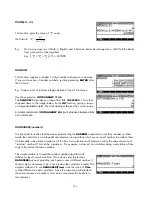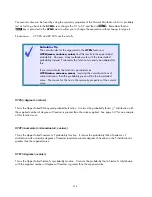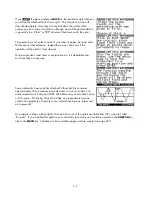
The list variables
Operations on lists
Statistical columns as lists
31
W
W
O
O
R
R
K
K
I
I
N
N
G
G
W
W
I
I
T
T
H
H
L
L
I
I
S
S
T
T
S
S
A list in the hp 39gs or hp 40gs is the equivalent of a mathematical set. As with a set, it is written as numbers
separated by commas and enclosed with curly brackets.
Eg.
{2,5,-2,10,3.75}
Using the
HOME
view these lists can be stored in special list variables.
There are ten of these
L1,L2,..L9,L0.
Eg.
{2,5,-2,10,3.75}
L1
Typing
L1
and then
ENTER
will then retrieve the list. Lists can also be
multiplied by a constant and have a constant added to them (see below)
If we store another list of the same length into
L2
, then the two lists can
be multiplied together. The resulting list is obtained by multiplying each
element in the first list by the matching element in the second list.
Many of the normal mathematical functions also work on lists of numbers by performing the operation on each
individual element. Lists on the calculator can contain more than simply numbers. For example, the return
value for some matrix functions is a list where each element is a matrix. Elements of a list can be matrices, lists
and many other things.
The column variables
C1,C2..C9,C0
in the Statistics aplet are actually
list variables attached to their aplet and can be used as extra storage if
you need more list variables. The statistical variables have the
additional advantage, of course, that they can be graphed in the
Statistics aplet and with all the usual statistical analysis measures
available. To transfer a list variable to a statistics variable, just store one
into the other (see right). As you can see in the second view, the list has
been transferred to
C1
. Pressing
would now give the usual
statistical measures for the newly created column.
215






























